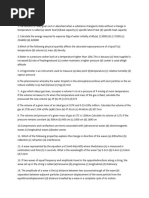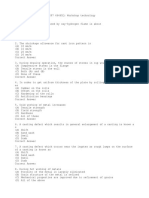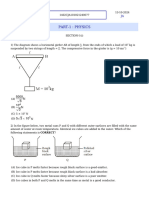Physics SS1
Physics SS1
Uploaded by
Abosede OgunboluCopyright:
Available Formats
Physics SS1
Physics SS1
Uploaded by
Abosede OgunboluOriginal Title
Copyright
Available Formats
Share this document
Did you find this document useful?
Is this content inappropriate?
Copyright:
Available Formats
Physics SS1
Physics SS1
Uploaded by
Abosede OgunboluCopyright:
Available Formats
CHRIST THE KING INTERNATIONAL SCHOOL, GBAGADA– LAGOS.
DEPARTMENT OF SCIENCE
SECOND MID TERM EXAM
2019/2020 ACADEMIC SESSION
SUBJECT: PHYSICS
CLASS: SS 1
DURATION: 1 HOUR
INSTRUCTION: Read the instruction and answer the questions.
1. The heat from the sun reaches the earth mainly by the process of (a) radiation (b) conduction (c)
convection (d) reflection.
2. Calculate the linear expansivity α of brass of length 120m, that assumes a new length of 120.5m when
heated through a temperature 1000C.(a) 4.2 x 10-5K-1 (b) 4.2 x 10-4K-1 (c) 5.2 x 10-5K-1 (d) 4.4 x10-4K-1.
3. If hot water is poured into a thick glass cup, the cup cracks because (a) glass cannot withstand high
temperatures. (b) Glass is an amorphous substance. (c) The inner and the outer walls of the cup expand at
different rate. (d) Coefficient of expansion of glass is high.
4. In which of the following situation is the expansion of a solid an advantage? (a) Buckling of railway lines
(b) seizing of bearings in motor vehicles (c) sagging of overhead cables (d) bimetallic strip thermometers.
5. The expansion of solid can be considered a disadvantage in the (a) fire alarm system (b) thermostat
(c) riveting of steel plates (d) balance wheel of a watch.
6. When water is heated between 00C and 40C, its density (a) increases for a while and then decreases.
(b) decreases for a while and then increases. (c) Increases (d) decreases.
7. In what range of temperature is the expansion of water anomalous? (a) +208 0C to +2120C (b) -800C to -760C
(c) -40C to 00C (d) 00C to +40C.
8. One of the most important applications of expansion of bimetallic strip is found in the construction of
(a) a thermostat (b) an altimeter (c) a thermocouple (d) a hygrometer.
9. A block of ice floats on water inside a container. If the ice gets completely melted, the level of water in the
container will (a) increase (b) remain the same (c) decrease (d) first decrease and the increase.
10. Mercury has an advantage over other liquids as thermometric liquid because it (a) has low expansivity
(b) has high conductivity (c) vaporized easily (d) has relatively low freezing point.
11. Absolute zero temperature can be defined as the temperature (a) at which the average kinetic energy of
its particles making up a body is zero (b) at which pure water changes to ice at standard atmospheric
pressure (c) of zero degree on Celsius scale (d) at which pure water and steam co-exist.
12. The purpose of constriction in clinical thermometer is to (a) prevent the mercury to expand beyond the
bulb (b) prevent the mercury from falling back into the bulb until required. (c) Enable the mercury to
expand slowly. (d) Serve as lower limit to the scale to be read.
13. The ice and the steam point of a certain thermometer are -200 and 1000 respectively. Calculate the Celsius
temperature corresponding to 700 on the thermometer (a) 84.00C (b) 75.00C (c) 64.00C (d) 58.00C.
14. Which of the following statements about a gas thermometer and the liquid in glass thermometer is
correct? (a) Mercury thermometers cannot be calibrated against a constant gas thermometer. (b)
Mercury thermometers are much more accurate than the gas thermometers. (c) gas thermometers have a
wider temperature range than mercury thermometers(d) Gas thermometers are less cumbersome than
Mercury in glass thermometers.
15. A platinum resistance thermometer has a resistance of 4Ω at 00C and 12 Ω at 1000C. Assuming that the
resistance changes uniformly with temperature, calculate the resistance of the thermometer when the
temperature is 450C. (a) 6.0 Ω (b) 6.4 Ω (c) 7.6 Ω (d) 8.4 Ω
16. A faulty thermometer registers 102.50C at 1000 C. if the thermometer has no zero error, what will it
register at 550C. (a)54.60C (b)55.00C (c) 56.00C (d) 56.40C.
17. A rod of initial length 2m at a temperature of 250C is heated to 800C. calculate the increase in length of the
rod if its linear expansivity is 4.0 x10-3k-1. (a) 0.26m (b) 0.44m (c) 0.53m (d) 0.84m.
18. It takes 4 minutes to boil a quantity of water using an electrical heating coil. How long will it take to boil
the same quantity of water using the same heating coil if the current is doubled? [Neglect any external
heat losses]. (a) 8 minutes (b) 4 minutes ( c) 2 minutes (d) 1 minute.
19. When table salt is added to ice, the melting point of the ice. (a) is raised (b) is lowered (c) remains
unchanged (d) is first raised, then lowered.
20. The process by which heat energy is transferred through material with position of particle remaining the
same is called (a) conduction (b) radiation (c) convection (d) constancy
21. Thermostats are used in the following except (a) air-conditioners (b) ovens (c) horns (d) electric laundry
irons.
22. Circulation of fresh air in a room is as a result of (a) radiation (b) conduction (c) convection (d) expansion.
23. Which of the following surfaces is best absorber of radiant energy? (a) White (b) black (c) red (d) yellow.
24. In which of the following are the molecules of water moving fastest? (a) Steam (b) ice (c) ice-water mixture
(d) water.
25. The temperature range of constant volume gas thermometer is (a) -2700C to 15000C (b) -2500C to 11550C
(c) -1800C to 15200C (d) -390C to 3560C.
26. Which of the following thermometric properties is very useful at low temperature? (a) Emf of a
thermocouple (b) length of a column of liquid in glass (c) speed of sound through helium (d) colour of light
emitted by a hot source.
27. Which of the following is not a liquid-in-glass thermometer? (a) Clinical thermometer (b) thermocouple
(c) mercury-in-glass thermometer (d) alcohol-in-glass thermometer.
28. All are unit of temperature except (a) Kelvin (b) joule (c) Fahrenheit (d) Celsius.
29. Which of the following is not used to determine the heat content of a body? (a) Mass of the body (b) volume of the
body (c) specific heat capacity of the body (d) temperature of the body.
30. The temperature 450C is the same as (a) 250F (b) 570F (c) 810F (d) 1130F.
SECTION B (ANSWER ALL)
1. (a) What is meant by the statement: The linear expansivity of zinc is 2.6x10 -5K-1? [2 marks]
(b) State ONE advantage and TWO disadvantages of thermal expansion of solids. [3 marks]
(c) A steel bridge is 500m in length, If the temperature varies from a day time high of 30 0C to a night
time low of 50C, and the linear expansivity of steel is 1.2x10-5K-1. What is the daily variation in length? [5
marks]
2. (a) Define temperature according to the kinetic molecular theory. [2 marks]
(b) List out FOUR types of thermometer with their temperature range. [4 marks]
(c) State THREE properties of a good thermometric liquid. [3 marks]
3. (a) What is the temperature range for clinical thermometer? [2 marks]
(b) Define the following terms (i) Lower fixed point (ii) upper fixed point. [3 marks]
(c) The ice and the steam points on a temperature scale are 50mm and 190mm respectively. What will
be the readings on this scale when the temperature is 700C? [5 marks]
You might also like
- ChE 210 Lecture 5 Material Balance With Chemical Reaction and Problems Involving Multiple UnitsDocument97 pagesChE 210 Lecture 5 Material Balance With Chemical Reaction and Problems Involving Multiple UnitsMay May MagluyanNo ratings yet
- PHYSICSDocument4 pagesPHYSICSPius Sonny Prince OseNo ratings yet
- Hostel SECOND TERM EXAMINATIONDocument6 pagesHostel SECOND TERM EXAMINATIONAlvan MmaduwubaNo ratings yet
- SS 1 Physics Second TermDocument11 pagesSS 1 Physics Second TermjeffallenchrisNo ratings yet
- Ss2 physics-WPS OfficeDocument3 pagesSs2 physics-WPS OfficeIsamah ChukwunaluNo ratings yet
- FIRST GARLAND Physics Secound Term ss1, ss2 2022Document9 pagesFIRST GARLAND Physics Secound Term ss1, ss2 2022Akahaotu Frank UgochukwuNo ratings yet
- Ss 1 Third Term Physics ExaminationDocument3 pagesSs 1 Third Term Physics ExaminationEmerald UwabunkeonyeNo ratings yet
- Properties of Bulk MatterDocument7 pagesProperties of Bulk MatterDont KnowNo ratings yet
- Temperature and HeatDocument17 pagesTemperature and HeatSubho BhattacharyaNo ratings yet
- THEORY BASED H&TDocument7 pagesTHEORY BASED H&TPriyanshu BhagatNo ratings yet
- Ss1 Physics 2nd TermDocument2 pagesSs1 Physics 2nd Termadenlatosin90No ratings yet
- Ss 2 Third Term Physics ExaminationDocument4 pagesSs 2 Third Term Physics ExaminationEmerald UwabunkeonyeNo ratings yet
- Physics Exam Questions For SS2 Second TermDocument15 pagesPhysics Exam Questions For SS2 Second TermShoon100% (5)
- Xi CH 10 Thermal Properties of MatterDocument28 pagesXi CH 10 Thermal Properties of Mattersargamray387No ratings yet
- Review Final Exam-NewDocument18 pagesReview Final Exam-NewhtyhongNo ratings yet
- 02 Thermal Expansion Practice ProblemDocument6 pages02 Thermal Expansion Practice Problemprem19999100% (1)
- EXERCISE 11.1: (Answer Key With Explanation)Document24 pagesEXERCISE 11.1: (Answer Key With Explanation)John MarksNo ratings yet
- NeetDocument2 pagesNeetUmesh ShivappaNo ratings yet
- Xii Centre Phy Neet DPT-28 01.08.24Document6 pagesXii Centre Phy Neet DPT-28 01.08.24Deena chemistNo ratings yet
- PhysicsDocument3 pagesPhysicsSOMOSCONo ratings yet
- 7th CBSE Heat Extra 2Document11 pages7th CBSE Heat Extra 2joydeepNo ratings yet
- Junior Neet WT QP 02-08-2021Document21 pagesJunior Neet WT QP 02-08-2021r3flexxNo ratings yet
- Physics ExerciseDocument6 pagesPhysics ExerciseLaw Jing SeeNo ratings yet
- SS1 Exam QuestionDocument3 pagesSS1 Exam QuestionMARYQUEEN AMARACHUKWUNo ratings yet
- SS1 PhysicsDocument2 pagesSS1 PhysicsPius Sonny Prince OseNo ratings yet
- IX Phy Heat Gaurav Kukreja FinalDocument10 pagesIX Phy Heat Gaurav Kukreja FinalAditya ParuiNo ratings yet
- Prelim 1Document5 pagesPrelim 1Dipesh PatelNo ratings yet
- Untitled DocumentDocument3 pagesUntitled DocumentDr ChemistNo ratings yet
- 02 Heat Question-BankDocument62 pages02 Heat Question-BankDébàshis Dash100% (1)
- Wassce Questions On SS1 TopicsDocument2 pagesWassce Questions On SS1 TopicsAlvan Mmaduwuba100% (3)
- Allahu Phy Ss1Document2 pagesAllahu Phy Ss1seun DosunmuNo ratings yet
- Physiiroko Community Grammer Schoolss2Document3 pagesPhysiiroko Community Grammer Schoolss2ogunfunminiyiestherNo ratings yet
- Thermal Expansion and CalorimetryDocument4 pagesThermal Expansion and CalorimetryAnish BondaNo ratings yet
- 1ST Year CH# 11 T-12Document3 pages1ST Year CH# 11 T-12Amir HabibNo ratings yet
- USS Physics-Pages-491-493Document3 pagesUSS Physics-Pages-491-493Arnav PatilNo ratings yet
- Chapter 11 Heat & ThermodynamicsDocument5 pagesChapter 11 Heat & ThermodynamicsZahid ArainNo ratings yet
- Exam - PHD Chemical Engineering Department University of Baghdad Date 13/8/2015 Time: 3 HrsDocument6 pagesExam - PHD Chemical Engineering Department University of Baghdad Date 13/8/2015 Time: 3 Hrshiba thamirNo ratings yet
- R N RN N R RN: Chapter No: 11Document4 pagesR N RN N R RN: Chapter No: 11luqmanNo ratings yet
- IMPORTANT MCQ-Heat Transfer 1 - WWW - ALLEXAMREVIEW.COM - PDFDocument19 pagesIMPORTANT MCQ-Heat Transfer 1 - WWW - ALLEXAMREVIEW.COM - PDFRobert Michael CorpusNo ratings yet
- Teacher Munuo Inocent 2015-2023 Physics Questions. - 015732Document30 pagesTeacher Munuo Inocent 2015-2023 Physics Questions. - 015732InoNo ratings yet
- Hapter: Conceptual ProblemsDocument17 pagesHapter: Conceptual ProblemsMalek AqlanNo ratings yet
- THERMAL PROPERTIES With SolDocument10 pagesTHERMAL PROPERTIES With SolbalramsharmaNo ratings yet
- SolutinDocument33 pagesSolutinharshkadhiwala008No ratings yet
- 20171206141215tutorial 1 - Chapter 1 and 2 - SchemeDocument5 pages20171206141215tutorial 1 - Chapter 1 and 2 - SchemeShahNo ratings yet
- Mechanical Engineering - Heat Transfer MCQ PDF: All Exam Review AddaDocument16 pagesMechanical Engineering - Heat Transfer MCQ PDF: All Exam Review AddaChetanNo ratings yet
- SolutionDocument16 pagesSolutionaaryajpbhat13No ratings yet
- ss3 2nd Term Exam PHYSICSDocument4 pagesss3 2nd Term Exam PHYSICSChukwudi MmereoleNo ratings yet
- Semister-1 Physics SEM-1: Multiple Choice QuestionsDocument4 pagesSemister-1 Physics SEM-1: Multiple Choice Questionsapi-235866525No ratings yet
- Chapter 11Document3 pagesChapter 11fazoolsiteNo ratings yet
- Form 4 Easter Exam 2022Document7 pagesForm 4 Easter Exam 2022TechnixFNNo ratings yet
- Ques BankDocument248 pagesQues BankShubham GuptaNo ratings yet
- 2024 Physics ExamDocument16 pages2024 Physics ExamOLUSOLA OLUBORODENo ratings yet
- Entry Exam - M.Sc. / 2015-2016 Chemical Engineering Department University of Baghdad Date 13/8/2015 Time: 3 HrsDocument5 pagesEntry Exam - M.Sc. / 2015-2016 Chemical Engineering Department University of Baghdad Date 13/8/2015 Time: 3 Hrshiba thamirNo ratings yet
- JWM 2017 Question PaperDocument38 pagesJWM 2017 Question PaperManish KumarNo ratings yet
- SolutioDocument24 pagesSolutioharshkadhiwala008No ratings yet
- MIDTERMSDocument3 pagesMIDTERMSMiya GomezNo ratings yet
- O-Level Physics Bank Questions, 2019 PDFDocument30 pagesO-Level Physics Bank Questions, 2019 PDFmukhtar ahmed50% (4)
- Cam Igcse Biology AnswersDocument134 pagesCam Igcse Biology AnswersAbosede OgunboluNo ratings yet
- Yr8 Fluent in Five, Summer Term Week 6Document11 pagesYr8 Fluent in Five, Summer Term Week 6Abosede OgunboluNo ratings yet
- Yr8 Fluent in Five, Summer Term Week 1Document11 pagesYr8 Fluent in Five, Summer Term Week 1Abosede OgunboluNo ratings yet
- Yr8 Fluent in Five, Summer Term Week 7Document11 pagesYr8 Fluent in Five, Summer Term Week 7Abosede OgunboluNo ratings yet
- Third Space Learning Changing The Subject of A Formula GCSE WorksheetDocument11 pagesThird Space Learning Changing The Subject of A Formula GCSE WorksheetAbosede OgunboluNo ratings yet
- Y9 Revision Homework Sheet Number 1 AnswersDocument4 pagesY9 Revision Homework Sheet Number 1 AnswersAbosede OgunboluNo ratings yet
- English 2014 Qu and AnsDocument16 pagesEnglish 2014 Qu and AnsAbosede OgunboluNo ratings yet
- Yr9 Fluent in Five, Summer Term Week 10Document11 pagesYr9 Fluent in Five, Summer Term Week 10Abosede OgunboluNo ratings yet
- Cambridge IGCSE™: Physics 0625/62 May/June 2021Document8 pagesCambridge IGCSE™: Physics 0625/62 May/June 2021Abosede OgunboluNo ratings yet
- Digital Weighing MachineDocument33 pagesDigital Weighing MachineUmakant RajpootNo ratings yet
- Gen FuncsDocument8 pagesGen FuncsAndrew PhungNo ratings yet
- Week 3 Landscape Fabric and DesigningDocument55 pagesWeek 3 Landscape Fabric and DesigningSinafike BekeleNo ratings yet
- 1Document2 pages1John Andrew GonzalesNo ratings yet
- Chen Et Al. - 2009 - Modified Sliding Mode Speed Control of BrushlessDocument4 pagesChen Et Al. - 2009 - Modified Sliding Mode Speed Control of Brushlesscarolain_msNo ratings yet
- Bses 28 Lab MidtermDocument3 pagesBses 28 Lab MidtermTrina CanizoNo ratings yet
- ME8595-Thermal Engineering-II Valliammai PDFDocument19 pagesME8595-Thermal Engineering-II Valliammai PDFSiva SubramaniamNo ratings yet
- Deep-Water Fine-Grained Sediments Facies ModelsDocument37 pagesDeep-Water Fine-Grained Sediments Facies ModelsRifano PongrekunNo ratings yet
- Chris McMullen - Essential Calculus-Based Physics Study Guide Workbook - The Laws of Motion Copie 3Document1 pageChris McMullen - Essential Calculus-Based Physics Study Guide Workbook - The Laws of Motion Copie 3youssef.hilali89yhNo ratings yet
- U Control For Cryogenic Turboexpanders PDFDocument6 pagesU Control For Cryogenic Turboexpanders PDFJose Luis Rodriguez LópezNo ratings yet
- Tuyển Tập Đề Thi Chuyên & HSG Nguyễn Trãi Hải DươngDocument98 pagesTuyển Tập Đề Thi Chuyên & HSG Nguyễn Trãi Hải Dương26-Phạm Đoàn Quỳnh Phương 1022No ratings yet
- The Relationship Between The Lifelong Learning Tendencies and Teacher Self-Efficacy Levels of Social Studies Teacher CandidatesDocument18 pagesThe Relationship Between The Lifelong Learning Tendencies and Teacher Self-Efficacy Levels of Social Studies Teacher CandidatesSoner ArıkNo ratings yet
- Color Value TestDocument1 pageColor Value TestJai MurugeshNo ratings yet
- BBA QT Assignment 1 - 114553Document2 pagesBBA QT Assignment 1 - 114553rtrnaNo ratings yet
- APRMAY18Document6 pagesAPRMAY18fantin amirtharajNo ratings yet
- Role of Bone Screw (Izc & BSS) in Skeletal Anchorage System - A Review ArticleDocument5 pagesRole of Bone Screw (Izc & BSS) in Skeletal Anchorage System - A Review ArticleAlvaro ChacónNo ratings yet
- Integer Programming: Canonical and Standard Form For IlpsDocument6 pagesInteger Programming: Canonical and Standard Form For IlpsNavi_85No ratings yet
- Three Phase Inverter: SE25K / SE33.3KDocument2 pagesThree Phase Inverter: SE25K / SE33.3KLeeNo ratings yet
- Martillo Hidraulico Excavadora PDFDocument62 pagesMartillo Hidraulico Excavadora PDFemanuel garciaNo ratings yet
- Tilt: A Time-Centric Approach For Stream Query Optimization and ParallelizationDocument15 pagesTilt: A Time-Centric Approach For Stream Query Optimization and Parallelizationdenyseptiawan84No ratings yet
- Image Quality Assessment For Magnetic Resonance ImDocument10 pagesImage Quality Assessment For Magnetic Resonance Imdududududu doraNo ratings yet
- Tikrit University College of EngineeringDocument12 pagesTikrit University College of EngineeringKarrar KarrarNo ratings yet
- 160.102 Algebra (Auckland, Manawat U, and Distance) Assignment 2. Due 11pm Tuesday 26 MayDocument2 pages160.102 Algebra (Auckland, Manawat U, and Distance) Assignment 2. Due 11pm Tuesday 26 MayAiman qayyumNo ratings yet
- Recurrent Convolutional Neural Networks For AMR Steganalysis Based On Pulse PositionDocument12 pagesRecurrent Convolutional Neural Networks For AMR Steganalysis Based On Pulse PositionBouhafs AbdelkaderNo ratings yet
- Unit Test 1 Unit Test 2A Unit Test 2 B Unit Test 3 Unit Test 4Document11 pagesUnit Test 1 Unit Test 2A Unit Test 2 B Unit Test 3 Unit Test 4Satya NarayanaNo ratings yet
- Sending Smart Forms in HTML FormatDocument9 pagesSending Smart Forms in HTML FormatChaithanyaNo ratings yet
- Document 1498831.1Document6 pagesDocument 1498831.1Marcos SoaresNo ratings yet
- ZSP-701 - SU - 360° Rotating Fire Protection SystemDocument50 pagesZSP-701 - SU - 360° Rotating Fire Protection SystemShrey MistryNo ratings yet
- Mech Engg 2-1 CS & Syllabus - UG - R20Document22 pagesMech Engg 2-1 CS & Syllabus - UG - R20Syam RajuNo ratings yet


































































































